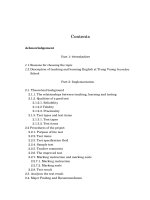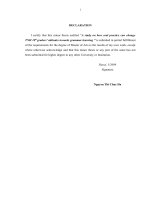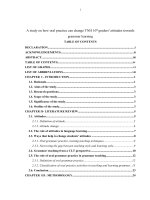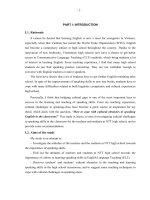A study on automated ribbon bridge installation strategy and control system design
Bạn đang xem bản rút gọn của tài liệu. Xem và tải ngay bản đầy đủ của tài liệu tại đây (4.15 MB, 113 trang )
Thesis for the Degree of Doctor of Philosophy
A Study on Automated Ribbon
Bridge Installation Strategy and
Control System Design
by
Van Trong Nguyen
Department of Mechanical System Engineering
The Graduate School
Pukyong National University
October 2018
A Study on Automated Ribbon
Bridge Installation Strategy and
Control System Design
부유식 교량 설치방법 및 제어시스템 구축에
관한 연구
by
Van Trong Nguyen
Advisor: Prof. Young-Bok Kim
A thesis submitted in partial fulfillment of the requirements for
the degree of Doctor of Philosophy
In Department of Mechanical System Engineering,
The Graduate School,
Pukyong National University
October 2018
Acknowledgments
Foremost, I would like to express my sincere gratitude to my
advisor Professor Young-Bok Kim for the continuous support of my
study and research, for his immense knowledge, motivation, patience,
and his enthusiasm. His endless kindness, insight supports, and strong
motivation encouraged and helped me to accomplish my research and
finish this dissertation scientifically. With all my respect and from
bottom of my heart, I wish my Professor and his family to have the
long-lived health and happiness.
I would like to thank the members of my thesis committee: Prof.
Suk-Ho Jung, Prof. Soo-Yol Ok, Prof. Jin-Ho Suh, and Dr. SangWon Ji who have provided wonderful feedback on my work and great
suggestions for better contribution of my dissertation.
I am also grateful to Prof. Kyoung-Joon Kim, my former Master
advisor, and Dr. Anh-Minh Duc Tran from Ton Duc Thang University
for essential assistances. Without their introduction, I would not have
the chance to finish my study in Marine Cybernetics Laboratory.
Besides, I would like to thank all members of Marine Cybernetics Laboratory for their cooperation, encouragement, and friendship
giving me a comfortable and active environment to achieve my work:
Manh Son Tran, Nhat Binh Le, Duc Quan Tran, Eun-Ho Choi, DongHoon Lee, Dae-Hwan Kim, Mi-Roo Sin, Soumayya Chakir and all
other foreign friends.
Thanks are due to all members of Vietnamese Students’ Association in Korea, especially Dr. Huy Hung Nguyen, Dr. Van Tu Duong,
i
Dr. Phuc Thinh Doan, Dr. Viet Thang Tran, Dr. Dac Chi Dang for
their vigorous supports and invaluable helps.
I would like to thank my parents, my older sister and all my close
relatives for their encouragement throughout my life. Without their
supports, there will be a lot of difficulties for my to finish my graduate
study seamlessly.
Finally, I owe more than thanks to my wonderful wife Thuy Linh
Dang for her unconditional love, endless encouragement not only all
the time of my study but also in whole of my life ahead.
Pukyong National University, Busan, Korea
October 26, 2018
Van Trong Nguyen
ii
Contents
Acknowledgment ..................................................................
i
Content ................................................................................. iii
Abstract ................................................................................ vi
List of Figures .......................................................................
x
List of Tables......................................................................... xvi
Abbreviation ......................................................................... xvii
Nomenclatures ......................................................................xviii
Chapter 1.
1.1
1.2
1.3
1.4
Introduction....................................................
1
Background and motivation .......................................
Problem Statements...................................................
Objective and researching method ..............................
Organization of dissertation .......................................
1
5
6
8
Chapter 2.
2.1
Induction of the Ribbon Bridge and Modeling 10
System description .................................................... 10
2.1.1 Overview of the ribbon floating bridge ............ 10
2.1.2
An automated installation and operation
strategy for RFBs........................................... 11
2.2
The ribbon floating bridge model description .............. 12
2.2.1 Mechanical design ......................................... 12
2.2.2
2.3
Electrical design ............................................ 15
The RFBs Modeling .................................................. 20
iii
2.3.1
General Modeling for Control of the RFBs ...... 20
2.3.2
The Pilot Model of the RFB Modeling for
Control Design .............................................. 22
2.4
2.5
System Identification ................................................. 25
Summary.................................................................. 29
Chapter 3.
Observer-Based Optimal Control Design
with Linear Quadratic Regulator Technique... 30
3.1
3.2
3.3
Introduction ..............................................................
Control System Framework........................................
Observer-based Control Design ..................................
3.3.1 State Observer Design....................................
3.3.2
3.4
3.5
3.6
30
31
35
35
Optimal Controller Design ............................. 38
Simulation Results .................................................... 42
Experimental Results................................................. 48
Summary.................................................................. 58
Chapter 4.
Motion Control Performance with Sliding
Mode Control Design ...................................... 59
4.1
4.2
4.3
4.4
4.5
Introduction ..............................................................
Sliding Mode Control of MIMO Underactuated System
Simulation results .....................................................
Experimental results ..................................................
Summary..................................................................
Chapter 5.
5.1
5.2
59
59
64
69
79
Conclusions and Future Works ....................... 81
Conclusions .............................................................. 81
Future works............................................................. 82
References............................................................................. 84
Publication and Conference .................................................. 88
iv
A Study on Automated Ribbon Bridge Installation Strategy and
Control System Design
Van Trong Nguyen
Department of Mechanical System Engineering,
The Graduate School, Pukyong National University
Abstract
Recently, Ribbon Floating Bridges are widely utilized in transportation, especially for emergency restoration in both military and
civil fields thanks to their great advantages of ability to transport
heavy combat vehicles, trucks, quick installation, and low environmental impacts. Since the installation and operation of the ribbon
floating bridge are mainly carried by manual work, these jobs may
contain high risks, particularly in dangerous situation and combat
time. Therefore, it is critical to propose an installation strategy and
self-operation automatically.
This dissertation aims to present a new approach for automated
installation and operation of the ribbon floating bridge by proposing a
mathematical modeling and designing a control system with different
approaches.
The floating bridge system consists a series of interior and ram
bays connected that can be considered as the multi-link manipulator.
It is confirmed that there is no previous study related to this object
although a lot of researchers paid attention to dynamic analysis. Bev
sides, the floating bridge systems normally work in continuous changing environment and are affected by various of uncertainties such as
current flow, moving load, and other external disturbances that can
lead to position displacement.
To successfully achieve the automatic installation and self-correction
positional displacement of the ribbon floating bridge, the integrated
propulsion systems are included and the yaw motion of every single bay is measured by the incremental encoder. The ribbon floating
bridge is loaded in one riverside and then is rotated to the desired
position across the river. In order to maintain the structure and operation of the bridge system, it is required to ensure the linearity of the
whole bridge and keep its desired position. To completely perform
these task, the followings are carried out:
● Firstly, the ribbon floating bridge system structure description
and dynamic analysis are discussed and system modeling of the ribbon floating bridge consisting of five individual coupled floating units
is given. In this system, there will be existences of two passive bays
that do not have propulsion systems. The remaining three active bays
are designed to integrate with three propulsion systems containing
azimuth propellers, direct current motors and motor drivers. Besides,
the yaw displacement between two continuous floating units is measured by the incremental encoder. The system modeling of the ribbon floating bridge describes the kinematics and kinetic of mechanical and electrical operation to obtain a dynamic system expressed by
state equations.
● Secondly, a number of experimental studies is conducted in order to identify the dynamic characteristics of the floating unit. Bevi
sides, the propulsion system is also identified through variety of experiments with different step inputs. In order to estimate the affection
of current flow disturbance, an experiment was carried out with several assumed water velocities. Among the obtained data, a representative model is selected. In addition, there are variety of states cannot
be measured directly for feedback, therefore, it is necessary to include a state estimator in control system. The linear state observer is
designed and implemented. The effectiveness and robustness of the
proposed state estimator are verified by numerical simulations and
experimental results.
● Thirdly, an optimal controller using Linear Quadratic Regulator (LQR) technique is designed and implemented. For the class of
MIMO linear system, the optimal control method is common used
for robust achievement. Based on previous proposed state observer,
the controller gains are defined with the assistance of Matlab software. To verify the sufficiency of the given observer-based controller,
a number of numerical simulations with various desired outputs and
distinctive environmental conditions are investigated. For further confirmation of practical feasibility of the proposed installation strategy
and control system, the experiment is executed in both calm water
basin and under wave disturbance attack. The obtained results indicate that the proposed control system satisfies the initial objectives.
● Finally, although the optimal LQR based state estimator controller is eligible to achieve the desired control performance, there
will be a raised problem caused by the uncertainties of external disturbance leading to slow response of controller to cope with continuous wave/current flow force. Hence, it is critical to improve the reacvii
tion time of controller that quickly adapts with uncertainties as well
as external disturbance. To eliminate with the unexpected attacks of
external disturbance and improve the reaction time, a sliding mode
controller (SMC) is proposed for under-actuated system. Simulation
and experimental results illustrate the effectiveness of the proposed
controller including the ability to overcome continuous wave during
installation phase and the robust stable of position keeping phase.
viii
List of Figures
Fig. 1.1
The actual ribbon bridge system..........................
Fig. 1.2
Conventional methods for ribbon bridge installation ................................................................
Fig. 2.1
2
3
A proposed installation strategy for the ribbon
bridge ............................................................... 12
Fig. 2.2
Diagram of five-bay ribbon bridge model structure 13
Fig. 2.3
Structure of the active bay .................................. 14
Fig. 2.4
Structure of the passive bay ................................ 15
Fig. 2.5
The configuration diagram of the control system .. 16
Fig. 2.6
The photo and specification of the incremental
encoder ............................................................. 16
Fig. 2.7
The photo and specification of NI PXIe-6363....... 18
Fig. 2.8
The photo and specification of NI PXI-6221 ........ 18
Fig. 2.9
The photo and specification of NI PXI-6221 ........ 19
Fig. 2.10 The photo and specification of DC motor............. 19
Fig. 2.11 The photo and specification of the propeller ......... 20
Fig. 2.12 The structure of five-floating unit bridge system ... 23
Fig. 2.13 The experiment setup for propulsion system
identification ..................................................... 26
Fig. 2.14 The input step voltage and the obtained output
force ................................................................. 26
Fig. 2.15 The fitting result of identified model for propulsion system........................................................ 27
ix
Fig. 2.16 The experiment setup for inertia and damping
coefficient identification ..................................... 28
Fig. 2.17 The least square data fitting result ....................... 28
Fig. 3.1
The servosystem for positional control of the
RFB system....................................................... 35
Fig. 3.2
The diagram of a full-state observer structure....... 36
Fig. 3.3
The yaw angle deviation of floating unit no. 1 ...... 43
Fig. 3.4
The yaw angle deviation of floating unit no. 2 ...... 43
Fig. 3.5
The yaw angle deviation of floating unit no. 3 ...... 43
Fig. 3.6
The yaw angle deviation of floating unit no. 4 ...... 44
Fig. 3.7
The yaw angle deviation of floating unit no. 5 ...... 44
Fig. 3.8
The control input voltage for propulsion systems
in ideal condition ............................................... 44
Fig. 3.9
The yaw motion of floating unit no. 1 under
disturbance ........................................................ 45
Fig. 3.10 The yaw motion of floating unit no. 2 under
disturbance ........................................................ 46
Fig. 3.11 The yaw motion of floating unit no. 3 under
disturbance ........................................................ 46
Fig. 3.12 The yaw motion of floating unit no. 4 under
disturbance ........................................................ 46
Fig. 3.13 The yaw motion of floating unit no. 5 under
disturbance ........................................................ 47
Fig. 3.14 The control input for propulsion systems under
disturbance ........................................................ 47
x
Fig. 3.15 The experiment setup for RFB installation and
position keeping control ..................................... 48
Fig. 3.16 The yaw motion of floating unit no. 1 in calm
water................................................................. 49
Fig. 3.17 The yaw motion of floating unit no. 2 in calm
water................................................................. 50
Fig. 3.18 The yaw motion of floating unit no. 3 in calm
water................................................................. 50
Fig. 3.19 The yaw motion of floating unit no. 4 in calm
water................................................................. 50
Fig. 3.20 The yaw motion of floating unit no. 5 in calm
water................................................................. 51
Fig. 3.21 The control input for propulsion systems in
calm water......................................................... 51
Fig. 3.22 The yaw angle displacement between #1 unit
and #2 unit ........................................................ 52
Fig. 3.23 The yaw angle displacement between #2 unit
and #3 unit ........................................................ 52
Fig. 3.24 The yaw angle displacement between #3 unit
and #4 unit ........................................................ 53
Fig. 3.25 The yaw angle displacement between #4 unit
and #5 unit ........................................................ 53
Fig. 3.26 The yaw motion of unit #1 with external disturbance ................................................................ 54
Fig. 3.27 The yaw motion of unit #1 with external disturbance ................................................................ 54
xi
Fig. 3.28 The yaw motion of unit #1 with external disturbance ................................................................ 54
Fig. 3.29 The yaw motion of unit #1 with external disturbance ................................................................ 55
Fig. 3.30 The yaw motion of unit #1 with external disturbance ................................................................ 55
Fig. 3.31 The control input for propulsion systems with
external disturbance ........................................... 55
Fig. 3.32 The yaw angle displacement between #1 unit
and #2 unit ........................................................ 56
Fig. 3.33 The yaw angle displacement between #2 unit
and #3 unit ........................................................ 56
Fig. 3.34 The yaw angle displacement between #3 unit
and #4 unit ........................................................ 57
Fig. 3.35 The yaw angle displacement between #4 unit
and #5 unit ........................................................ 57
Fig. 4.1
Yaw angle deviation of floating unit #1................ 67
Fig. 4.2
Yaw angle deviation of floating unit #2................ 67
Fig. 4.3
Yaw angle deviation of floating unit #3................ 67
Fig. 4.4
Yaw angle deviation of floating unit #4................ 68
Fig. 4.5
Yaw angle deviation of floating unit #5................ 68
Fig. 4.6
Force command inputs for propulsion systems ..... 68
Fig. 4.7
The yaw motion of unit #1 with SMC in calm
water................................................................. 70
Fig. 4.8
The yaw motion of unit #1 with SMC in calm
water................................................................. 70
xii
Fig. 4.10 The yaw motion of unit #1 with SMC in calm
water................................................................. 70
Fig. 4.9
The yaw motion of unit #1 with SMC in calm
water................................................................. 71
Fig. 4.11 The yaw motion of unit #1 with SMC in calm
water................................................................. 71
Fig. 4.12 The yaw displacement between unit #1 and unit
#2 with SMC in calm water ................................ 72
Fig. 4.13 The yaw displacement between unit #2 and unit
#3 with SMC in calm water ................................ 72
Fig. 4.14 The yaw displacement between unit #3 and unit
#4 with SMC in calm water ................................ 73
Fig. 4.15 The yaw displacement between unit #4 and unit
#5 with SMC in calm water ................................ 73
Fig. 4.16 The control forces generated by propulsion
system in calm water condition ........................... 74
Fig. 4.17 The yaw motion of unit #1 with SMC under
disturbance ........................................................ 75
Fig. 4.18 The yaw motion of unit #2 with SMC under
disturbance ........................................................ 75
Fig. 4.19 The yaw motion of unit #3 with SMC under
disturbance ........................................................ 75
Fig. 4.20 The yaw motion of unit #4 with SMC under
disturbance ........................................................ 76
Fig. 4.21 The yaw motion of unit #5 with SMC under
disturbance ........................................................ 76
xiii
Fig. 4.22 The yaw displacement between unit #1 and unit
#2 under disturbance .......................................... 77
Fig. 4.23 The yaw displacement between unit #2 and unit
#3 under disturbance .......................................... 77
Fig. 4.24 The yaw displacement between unit #3 and unit
#4 under disturbance .......................................... 78
Fig. 4.25 The yaw displacement between unit #4 and unit
#5 under disturbance .......................................... 78
Fig. 4.26 The force commands generated by propulsion
systems under disturbance condition ................... 79
xiv
List of Tables
Table 2.1
Parameters of floating unit ............................... 14
Table 2.2
Detailed specification of the PXIe-8115 embedded controller ............................................ 17
xv
Abbreviation
DAQ
Data Acquisition
DC
Direct current
IRB
Improved Ribbon Bridge
LQR
Linear Quadratic Regulator
MIMO
Multi input multie output
RFB
Ribbon Floating Bridge
SMC
Sliding mode control
xvi
Nomenclatures
Symbol
Description
Unit
A
Dynamic influence matrix of RFB system for
-
LQR design
As
Dynamic modeling matrix of RFB system for
-
SMC design
ai
Element of the matrix A
-
B
Input matrix of RFB system for LQR design
-
Bs
Input matrix of RFB system for SMC design
-
bi
Element of the matrix B
-
C
Output matrix of RFB system for LQR design
-
Cs
Output matrix of RFB system for SMC design
-
ci
The damping coefficient of the joint connect-
Nms.rad −1
ing the ith and the (i + 1)th floating units
cˆi
The absolute damping coefficient of ith floating
Nms.rad −1
unit
d
Influence matrix of disturbance
-
e
State error vector
-
ex
State error vector of the estimator
-
Filu
The spring forces at the upper left-hand-side
N
Fild
The spring forces at the lower left-hand-side
N
Firu
The spring forces at the upper right-hand-side
N
Fird
The spring forces at the lower right-hand-side
N
Fi p
The force generated by the propulsion system
N
xvii
Fiw
The water current flow force attacking to each
N
floating unit
h
The arm of spring force
m
I
Unit matrix
-
Ji
Moment of inertia of ith floating unit
kg.m2
Iz
The inertia moment of the floating unit on the
-
fixed z-axis
Kfw
Control gain matrix for LQR controller
-
Ks
Gain matrix for SMC
-
kiu
The stiffness coefficient of the upper transla-
N.m−1
tion spring connecting the ith and the (i + 1)th
floating units
kid
The stiffness coefficient of the lower transla-
N.m−1
tion spring connecting the ith and the (i + 1)th
floating units
L∶
Observer gain matrix
-
m
The floating unit’s mass
kg
P
Positive symmetric definite matrix
-
Q
Positive definite matrix
-
R
Positive definite matrix
-
T
Transformation matrix
-
Ti
The external torque acting on the ith floating
N.m
unit
r
Desired output yaw angle vector
-
u
Control input vector
-
x
Modeling state variable vector
-
xviii
xiu
The upper linear relative displacement between
-
the ith and the (i + 1)th floating units
xid
The lower linear relative displacement between
-
the ith and the (i + 1)th floating units
xˆ
Estimated state variable vector
-
wd
The water current disturbance vector
-
wv
The arms of propulsion and water current
m
forces
θi
The yaw angle of the ith floating unit (in this
rad
study, the counterclockwise is the forward direction of rotation motion)
θ˙i
The yaw velocity of the ith floating unit
rad.s−1
θ¨i
The yaw acceleration of the ith floating unit
rad.s−2
τ
Control input forces and moments
N ⋅m
γ
Positive constant
-
xix
Chapter 1.
1.1
Introduction
Background and motivation
With the dense network of water obstacles around the world such
as rivers, lakes, and channels, the demand of water crossing is getting
more and more important. Regarding the means of water obstacle
crossing, it may refer to several efficient methods [1] as follows:
• Bridging system is the most popular structure until now. In
term of water crossing purpose, the bridge is constructed to
connect two sides of rivers, lakes, or even ocean. There are
many designs of bridge systems that satisfy particular objectives or different conditions. However, there are two main types
of bridges that can be considered as permanent bridges (fixed
bridge) which are build in a place and the others are temporal bridges that can be portable and rebuild in any necessary
place. The ribbon floating bridge, one particular kind of temporal bridge system, will be the major object of our study.
• The second type should be tunnel. The tunnel is far different
from other kinds of water obstacle crossing with the underground structure or dug through the surrounding soil/earth/rock.
• Another type of popular water obstacle crossing is ferry. Its
operation is similar to the surface vessel but in short distance
and the main tasks are carrying passengers, vehicles, and cargo
across a body of water.
In term of temporal bridging, the ribbon floating bridge [2], also
1
called foldable float bridge is great importance for transportation, especially for emergency restoration in both military and civil fields.
Compared to land-based bridges, there are variety of recognized advantages such as the ability to transport heavy loads including vehicles, rapid installation, uncomplicated structure, and low environmental impacts. The most significant characteristic that is only available in this means of bridging is the ability to relocate thanks to its
great portability.
Fig. 1.1 The actual ribbon bridge system
The ribbon floating bridge was developed in 1970s in both Germany by the former EWK and by the company in US and by NATO
agreement it was decided to make both systems fully inter-operable.
Since then, the ribbon floating bridges are commonly used in army
force of different countries including Germany, Canada, Australia,
US, and so on with great success [3]. The actual structure of the ribbon float can be seen at Fig. 1.1. Most floating bridges are made from
2









